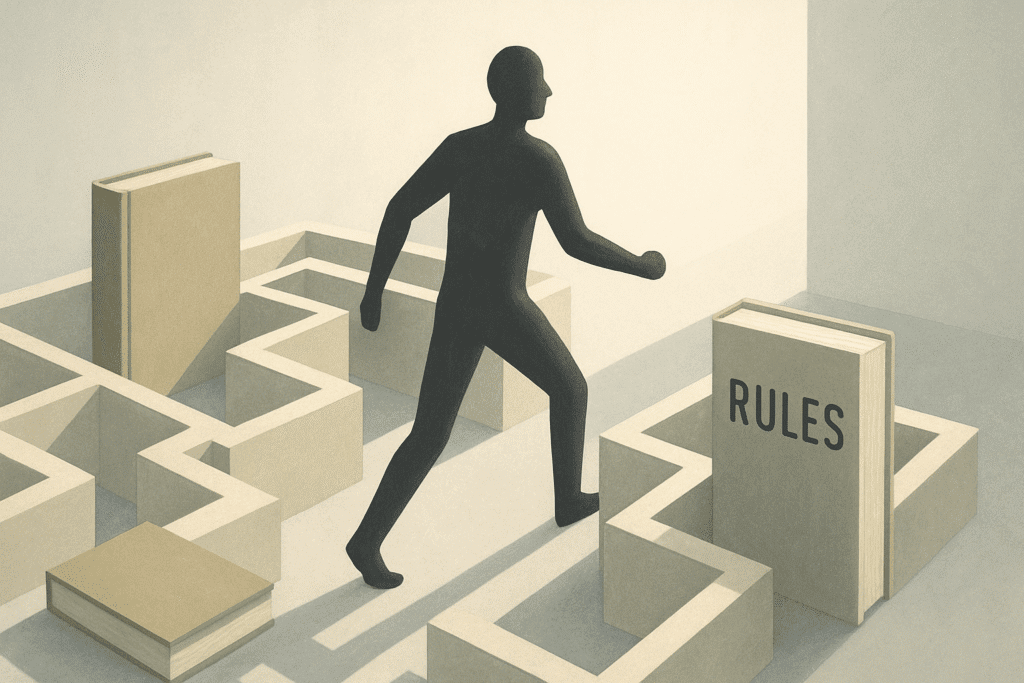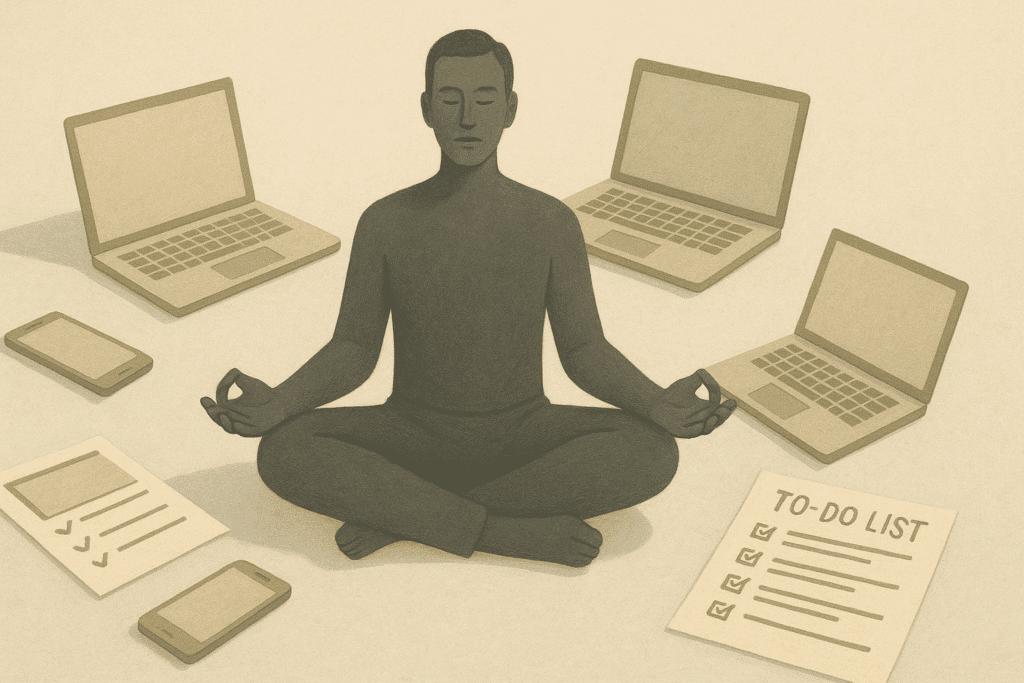Introduction

Stephen Covey’s The 7 Habits of Highly Effective People has earned near-iconic status in business circles, leadership seminars, and self-improvement culture. With over 25 million copies sold, it’s routinely found on top reading lists and executive bookshelves, often revered as a timeless formula for personal and professional success.
But reverence doesn’t always equate to relevance.
Despite its popularity, Covey’s framework leans heavily on a rigid moral philosophy, corporate-centric ideals, and a somewhat dated understanding of human behavior. The book presents its seven habits as universal truths, yet many of its principles are steeped in Western religious values and a one-size-fits-all mindset that often misses the mark in today’s diverse and dynamic world.
Even many of the book’s supporters concede that its case studies feel scripted, its language buzzword-heavy, and its scenarios—especially those involving family and work—unrealistically idealized. While Covey promotes the importance of character over personality, his approach tends to oversimplify deeply complex human challenges, offering clarity at the cost of nuance.
That’s not to say The 7 Habits lacks merit. But in an era where adaptability, emotional intelligence, and systemic thinking matter more than rigid formulas, it may be time to question whether this celebrated guide still deserves its sacred status—or if it’s simply an artifact of a different age.
The “Character Ethic” vs. Reality
Stephen Covey begins The 7 Habits of Highly Effective People with a striking premise: modern self-help has gone astray. He draws a clean line between two opposing philosophies of personal development:
- Character Ethic: Anchored in virtues like integrity, patience, courage, and humility.
- Personality Ethic: Focused on image, techniques, charisma, and superficial success.
According to Covey, true effectiveness isn’t found in surface-level tricks but in a principled, character-driven life built “from the inside out.” It’s a compelling idea—but one that doesn’t fully hold up under scrutiny.
Where the Model Falls Short
1. It Overlooks Structural and Psychological Realities
Covey’s framework implies that with enough character, anyone can succeed. But that overlooks a crucial truth: people don’t begin on equal footing. Mental health struggles, past trauma, systemic inequality, and social barriers all play a role in shaping a person’s capacity to “build character.” His model leans into a meritocratic ideal that doesn’t reflect the complexity of real-life challenges.
2. It Turns Personal Struggle into a Moral Issue
By framing success as a reflection of moral virtue, Covey inadvertently casts failure as a sign of moral weakness. This mindset can lead readers to internalize shame—believing they’re undisciplined or defective if they can’t live up to the habits. Instead of offering support, it risks becoming a source of guilt.
3. It Centers a Western, Individualist Worldview
The virtues Covey champions—like self-reliance, delayed gratification, and personal discipline—are deeply rooted in Western, particularly Judeo-Christian and American, ideals. In collectivist cultures or communities that emphasize interdependence over independence, this approach can feel out of step, even alienating.
A More Balanced Perspective
Covey’s focus on character isn’t without value—but it can unintentionally serve as a tool for self-criticism, especially in performance-driven environments. As one critique puts it:
“Covey’s Character Ethic is noble in theory, but in practice, it often becomes a tool for self-surveillance and moral judgment, especially in corporate environments.”
— Adapted from Shortform
Real growth requires more than just personal virtue. It demands context, compassion, and a recognition that human development isn’t always linear—or fair.
Habit 1: “Be Proactive” — Or Just Ignore Your Limits?

Covey opens his framework with Habit 1: Be Proactive, which he describes as the foundation for personal growth. At its core, the message is about ownership—about recognizing that, regardless of external circumstances, we always have the power to choose our response. On paper, it sounds empowering and motivational.
But the principle, when taken at face value, carries risks. Critics argue that this emphasis on individual agency can turn into a form of denial—one that ignores structural realities, emotional complexity, and human limitations.
Where Covey’s Approach Breaks Down
1. An Overload of Personal Responsibility
Covey’s philosophy leans heavily on the idea that external conditions—like trauma, inequality, or even mental health—are merely obstacles to overcome, not legitimate factors that shape behavior. While the intent is to encourage personal strength, it can end up invalidating real psychological or social struggles. For those facing chronic stress, neurodivergence, or generational disadvantage, this message can feel less like empowerment and more like blame.
2. The Environment Still Matters
Covey contrasts the “proactive” person—who acts based on values—with the “reactive” one, who blames others or circumstances. But this binary oversimplifies how human behavior actually works. Modern psychology and behavioral science show that our decisions are deeply influenced by context, upbringing, and biology. The idea that we can always override those forces with willpower alone isn’t just unrealistic—it’s misleading.
3. Encourages Self-Gaslighting
When internalized, this habit can push people to deny their own emotional or physical boundaries. If you’re struggling, the logic goes, it must be because you’re not being proactive enough. In environments where burnout is normalized—especially in high-pressure workplaces—this mentality can feed a cycle of over-responsibility and toxic positivity.
A More Grounded Interpretation
Covey famously wrote, “Between stimulus and response is our greatest power—we have the freedom to choose.” It’s a powerful idea. But that freedom isn’t infinite. It’s shaped by past trauma, systemic barriers, mental health, and privilege. Recognizing the limits of that choice isn’t a failure of character—it’s a sign of self-awareness.
True proactivity isn’t about denying your circumstances. It’s about navigating them with clarity, compassion, and realism.
Habit 2: “Begin with the End in Mind” — The Illusion of Control
In Habit 2, Covey urges readers to “Begin with the End in Mind”—a call to define your long-term vision and align your actions with that purpose. It’s a compelling idea: design your life deliberately, rather than drifting through it. To drive the point home, Covey even suggests a visualization exercise where you imagine your own funeral and reflect on how you want to be remembered.
While the habit promotes clarity and intention, it also rests on a deeper flaw: the belief that we can clearly map out our future and stay on that course. In truth, life rarely unfolds according to plan.
Where the Model Falls Apart
1. Overconfidence in Predictability
Covey’s advice assumes that people can accurately forecast who they’ll become and what they’ll value years or decades down the line. But research in psychology shows that identities, priorities, and even core values often shift over time. Locking onto a rigid “end” too early can limit growth, narrow your perspective, and cause you to miss out on new paths that emerge organically.
2. Underestimates the Power of Uncertainty
While Covey encourages intentionality, his model overlooks how much of life is shaped by unpredictability—chance encounters, unexpected setbacks, new relationships, or sudden opportunities. These unplanned moments often shape us more than anything we meticulously design. Covey’s framework leaves little room for reinvention, which is often where the real breakthroughs happen.
3. Risk of Perfectionism and Anxiety
When people internalize a clear, idealized vision of their future, they may begin to judge themselves harshly for falling short of it. This mindset can lead to over-planning, perfectionism, and a persistent feeling of not doing or being enough. Especially in cultures where achievement is overemphasized, “beginning with the end in mind” can become a source of quiet pressure rather than empowerment.
A More Adaptive Way Forward
Covey writes, “There’s no point climbing the ladder of success if it’s leaning against the wrong wall.” That’s true—but in a world where the wall can move, or disappear altogether, the better strategy is adaptability. Rather than rigid life plans, what many people need is a flexible compass—one that can be recalibrated as values shift, circumstances evolve, and new opportunities emerge.
Living with intention doesn’t mean living with certainty. The most meaningful paths often aren’t the ones we plan—they’re the ones we learn to recognize and embrace along the way.
Habit 4: “Think Win-Win” — Naïve in a Cutthroat World

Covey’s fourth habit, Think Win-Win, centers on the idea that every interaction can—and ideally should—result in mutual benefit. It’s built on the “abundance mindset,” the belief that there’s plenty of success, recognition, and opportunity to go around. At first glance, it’s an inspiring philosophy that encourages collaboration over competition.
But in the real world—especially in environments shaped by power imbalances, scarcity, or cutthroat dynamics—this ideal can fall apart quickly. What sounds like harmony can, in practice, turn into naivety or self-sacrifice.
Where the Model Overreaches
1. Assumes a Level Playing Field
The win-win mindset assumes both parties have equal power, good intentions, and a shared interest in fairness. But in many situations—whether it’s corporate hierarchies, manipulative relationships, or toxic workplace dynamics—that balance simply doesn’t exist. Expecting a mutual win when one side holds all the leverage can leave people vulnerable to exploitation or emotional coercion.
2. Overlooks the Value of Constructive Conflict
Covey positions win-win as the ideal, while treating conflict as something to be transcended. But not all conflict is negative. Sometimes, setting firm boundaries, saying no, or walking away is the healthiest and most strategic move. By placing harmony above all else, the model can discourage people—especially those conditioned to be agreeable—from advocating for themselves when it matters most.
3. Risks Reinforcing People-Pleasing
The desire to make every outcome a win for everyone can create pressure to constantly accommodate others. In practice, “win-win” can easily become “you win, I compromise.” This is especially true for individuals in marginalized or underrepresented groups, where social dynamics already push for over-performance, emotional labor, and self-silencing.
A More Realistic Alternative
A quote adapted from Covey’s own training materials puts it well:
“Win-win is a beautiful idea—but only when both sides are playing the same game.”
In many real-world negotiations, the healthier model is “win-learn.” You may not walk away with the outcome you envisioned, but you gain something more valuable: insight, clarity, or the strength to set firmer boundaries next time. That’s not failure—it’s growth.
Habit 6: “Synergize” — Buzzword Without Substance
The sixth habit in Covey’s framework, Synergize, is presented as the pinnacle of creative collaboration. It’s about celebrating diversity, embracing open dialogue, and producing results that are greater than what any individual could achieve alone. Covey famously describes synergy as the phenomenon where “1 + 1 = 3, or 10, or 1,000.”
It’s a poetic notion. But in practice, many find it frustratingly vague. Critics argue that Synergize reads more like a motivational slogan than a practical strategy. Instead of offering clear guidance, it often becomes a placeholder for forced teamwork and surface-level harmony.
The Gaps in the Concept
1. Vague by Design
Covey uses metaphors—like orchestras or gourmet recipes—to illustrate synergy, but never truly defines what it looks like in action. The idea that collaboration inherently produces exponentially better outcomes is appealing, but rarely provable. In many workplaces, “synergy” becomes a buzzword used to promote consensus without clarity, often masking inefficiency or vague decision-making.
2. Minimizes the Cost of Collaboration
Real collaboration isn’t a tidy, inspirational process. It involves disagreements, competing priorities, emotional labor, and a significant investment of time. Covey’s model assumes that differences naturally spark innovation. In reality, they can just as easily result in delays, politics, or groupthink—especially when teams lack trust or shared vision.
3. Can Be Used to Suppress Dissent
In some corporate environments, the call for “synergy” becomes a way to silence independent thought. Dissenting voices are labeled uncooperative, and genuine disagreements are reframed as obstacles to unity. Rather than encouraging dynamic dialogue, synergy-talk can be used to flatten differences and enforce conformity under the guise of collaboration.
What Covey Was Reaching For
FranklinCovey defines synergy as “valuing differences” and seeking a “third alternative” that’s better than what either party initially proposed. As a goal, that’s compelling. But synergy isn’t something that can be willed into existence. It’s not a habit—it’s an outcome. And reaching it requires more than just good intentions: it demands psychological safety, mutual respect, and a willingness to navigate tension, not avoid it.
In truth, the conditions for genuine synergy are rare. When they happen, the results can be transformative. But when misapplied, the term becomes a stand-in for shallow cooperation—and that’s when it loses all meaning.
Habit 7: “Sharpen the Saw” — Self-Care or Self-Optimization?

Covey’s final habit, Sharpen the Saw, is described as the habit that sustains all the others. It’s a call for regular renewal—physically, mentally, emotionally, and spiritually. The idea is simple: if you don’t take care of yourself, you can’t be effective in the long term. On the surface, it sounds like a refreshing push for balance and well-being.
But under closer scrutiny, this habit often becomes less about genuine rest and more about strategic maintenance—a version of self-care that’s ultimately in service of doing more, not being well.
Where the Message Gets Distorted
1. Rest as a Means to an End
Covey’s language repeatedly emphasizes performance—phrases like “increasing capacity,” “handling challenges,” and “producing results” turn recovery into a form of productivity. The implication is that rest and renewal are only worthwhile if they help you come back sharper, faster, and more efficient. It’s a mindset that dovetails with hustle culture, where even downtime must justify itself.
2. Oversimplifies Emotional Well-Being
Covey breaks self-renewal into four tidy categories, suggesting that regular maintenance will keep you balanced and energized. But human wellness doesn’t follow a neat checklist. Real renewal often involves discomfort, stillness, emotional processing, and sometimes even withdrawing from the systems that demand constant optimization. You can’t always journal your way through burnout or meditate your way out of grief.
3. Creates Pressure to “Do Self-Care Right”
When self-care becomes another habit to track, it can start to feel like a chore. People begin to feel guilty for not exercising enough, not meditating “properly,” or not making the most of their downtime. Instead of feeling restored, they feel like they’re falling behind—even in their attempts to relax. What was meant to be healing becomes another performance metric.
Toward a Gentler Interpretation
Covey’s metaphor—“sharpen the saw”—has value, but only if we remember that we’re not machines. As one critique puts it:
“Sharpening the saw is a useful metaphor—but only if we remember that we’re not tools.”
— Inspired by Art of Manliness
True self-care isn’t about improving output. It’s about honoring your limits, tending to your inner life, and giving yourself space to just exist—without needing it to make you more efficient. Sometimes, the most effective thing you can do is rest for no reason at all.
Recommended Books
If you’re looking for a book that balances personal development with psychological depth—without falling into the trap of corporate platitudes—consider this alternative:
📘 The Subtle Art of Not Giving a Fck by Mark Manson
Manson offers a refreshing, brutally honest take on self-help. Instead of pushing relentless positivity or rigid habits, he encourages readers to embrace their limitations, make peace with discomfort, and focus on what truly matters. It’s an antidote to the overly idealistic frameworks found in traditional self-help—Covey’s included.
Why it’s worth reading:
- Challenges the myth of constant self-optimization
- Blends humor with philosophical insight
- Offers a more realistic model of growth, grounded in acceptance rather than performance
If Covey’s 7 Habits feels a bit too polished or prescriptive, Manson’s raw, human approach might be the perspective you didn’t know you needed.
Conclusion: Why The 7 Habits Need a Rethink
Stephen Covey’s The 7 Habits of Highly Effective People has left a lasting mark on leadership literature and personal development. Its influence is undeniable. For many, it served as an introduction to structured self-improvement—discipline, clarity, and purpose.
But decades later, its shortcomings are harder to ignore.
Covey’s habits promote a version of success grounded in moral certainties, personal willpower, and structured discipline. What they often leave out are the realities that define most modern lives: mental health struggles, systemic barriers, emotional complexity, and the simple unpredictability of being human.
In a world increasingly shaped by uncertainty, burnout, and shifting cultural norms, The 7 Habits can feel less like a guide to resilience and more like a relic from a more rigid, corporate era.
What We Need Now
- Adaptability over rigid planning
- Compassion over control
- Systems thinking over self-blame
- Emotional intelligence over moral absolutism
The habits still hold value—but only when approached critically, with an understanding that no framework is universal. Covey once wrote, “Correct principles are like lighthouses—they do not move.” But maybe that’s exactly the issue. In a world in motion, static principles can become blind spots.
What we need today aren’t unmoving lighthouses—we need tools that move with us. Frameworks that evolve, that acknowledge complexity, and that leave space for both imperfection and growth.
FAQs
Is The 7 Habits of Highly Effective People still relevant today?
Yes—and no. While some of Covey’s principles (like taking initiative or clarifying your values) remain useful, others feel outdated in today’s fast-paced, emotionally complex world. The book often overlooks mental health, social inequity, and the limits of individual control.
What’s the biggest flaw in Covey’s 7 Habits framework?
The biggest flaw is its assumption that success comes primarily from moral clarity and personal discipline. It downplays structural barriers, emotional realities, and the unpredictable nature of modern life. This can lead readers to blame themselves for struggles that are systemic or circumstantial.
Are the 7 Habits harmful?
Not inherently—but they can become harmful if taken as rigid rules rather than flexible guidelines. When the habits are used to push toxic productivity, deny emotional nuance, or encourage self-blame, they can do more harm than good.
Can I still learn something valuable from the book?
Absolutely. The key is to read it critically. Extract what works for your context, and discard what doesn’t. The goal isn’t to reject Covey outright, but to engage with his ideas in a way that’s reflective, modern, and compassionate.
What are some modern alternatives to The 7 Habits?
The Subtle Art of Not Giving a Fck* by Mark Manson — focuses on values, boundaries, and emotional realism.
Burnout by Emily and Amelia Nagoski — explores the emotional and physical toll of modern work culture.
Atomic Habits by James Clear — offers behavior change strategies grounded in neuroscience and adaptability, without moralizing.
